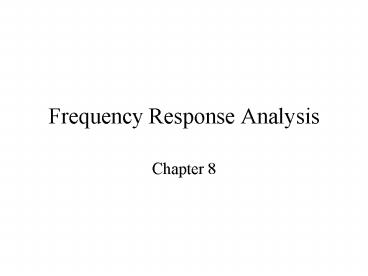Frequency Response Analysis - PowerPoint PPT Presentation
1 / 16
Title:
Frequency Response Analysis
Description:
Frequency Response Analysis Chapter 8 Outline Segway from earlier work Hanging Spring Mass Damper Transfer Functions Fundamental Theorem of Linear Systems Graphical ... – PowerPoint PPT presentation
Number of Views:190
Avg rating:3.0/5.0
Title: Frequency Response Analysis
1
Frequency Response Analysis
- Chapter 8
2
Outline
- Segway from earlier work
- Fundamental Theorem of Linear Systems
- Graphical representations of TFs
- Bode Diagrams (Section 8.2)
- Bode Diagrams with Matlab (Section 8.3)
- Phase and Gain margins Resonant Peak Magnitude
and Resonant Frequency Correlation between step
transient response and Frequency Response in
standard 2nd order system (some of Section 8.9)
See FE Reference - Ungraded HW. A problems 15, 16 (def of
bandwidth), 19 (need def of miniphase) - Graded HW. B problems 1, 2, 4 (check with
MatLab), 6, 26, 27, 29
3
Segway from earlier work
We have solved several forms of a problem in the
past. We will re-solve a form of this problem
now. The solution process reviews several issues
that allow us to solve the central result that
forms the foundation of frequency
analysis. Consider computing the acceleration
that a spring-mass-damper system experiences when
it is released from rest.
4
Hanging Spring Mass Damper
Prototype form
Prototype parameters and problem parameters
Ink/chalk/lead/space saving names
5
Transfer Functions
Relating position to input
Relating acceleration to input
Acceleration due to a step input
Inverse Laplace transforming
6
(No Transcript)
7
(No Transcript)
8
Fundamental Theorem of Linear Systems
Summarizes the steady state response of a stable
linear time invariant system to a sinusoidal
input.
Sinusoidal inputs are common in nature, are easy
to obtain in the lab.
Consider a stable system with transfer function
G(s) and input
9
(No Transcript)
10
Compare input function to steady-state
output. Draw conclusions. Magnitude and phase of
G(s) are important.
11
Graphical Representation of TFs
Bode plots.
Nyquist plots.
Polar plot parameter
12
Bode Diagrams (Section 8.2)
13
Bode Diagrams with Matlab (Section 8.3)
14
Phase and Gain margins
See FE manual. Compare with 562 and 563.
15
Resonant Peak Magnitude and Resonant Frequency
Consider 2nd order prototype system. Put TF in
Magnitude/phase (I.e. polar) form. Find frequency
of maximum magnitude (resonant frequency). Find
corresponding Maximum magnitude (resonant peak
magnitude).
A large resonant peak magnitude indicats the
presence of a pair of dominant closed loop poles
with small damping ratio. (BAD) A smaller
resonant peak magnitude indicates a well damped
closed loop system. (GOOD). Resonant frequency is
real only for damping ratio less than .707. No
closed loop resonance for damping ratio greater
than .707.
16
Correlation between step transient response and
Frequency Response in standard 2nd order system
Consider unity gain negative feedback system with
Phase margin is
See pg. 570.
Cross over frequency is































